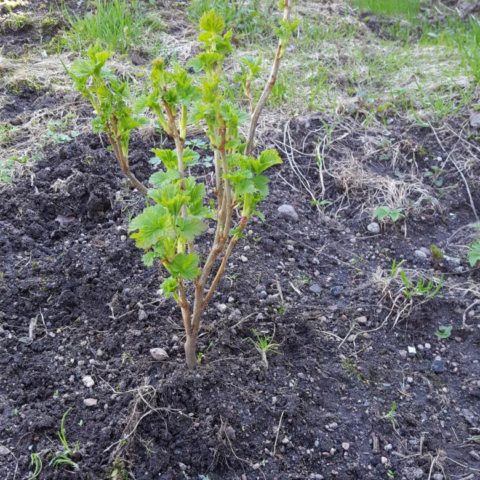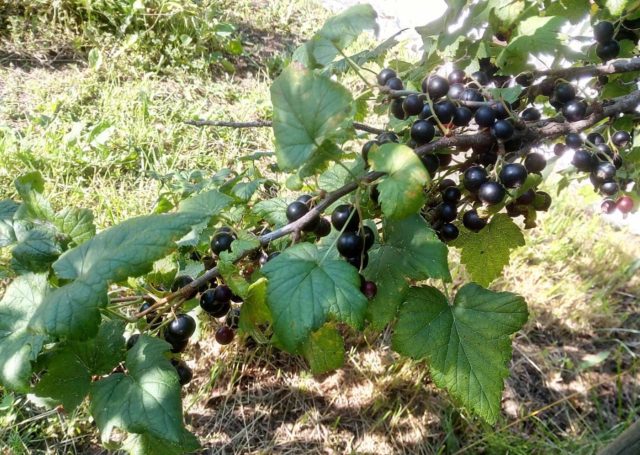Content
Dove currant bred by Siberian breeders. Its value lies in early ripening, yield, drought resistance. The variety was entered in the State Register of the Russian Federation in 1984 under the name Dove Seedling.
Description of the variety of currant Dove
The Golubka currant variety is intended for cultivation in the middle lane, in the Urals and Siberia. It looks like a medium-sized, slightly spreading bush. Its shoots are thin, upright, fawn in color. Young branches are green. The kidneys are medium in size, egg-shaped, with a pointed tip, yellow-brown in color.
Dove currant leaves are five-lobed, wrinkled, of medium size. The leaf plate is shiny, dark green, with wavy edges. The blades are pronounced, pointed. Petioles are short, green, located at an acute angle to the shoots.
The flowers are of medium size goblet type. Sepals are light green, bent. The brushes are medium-sized, dense, 6 cm long. They have from 6 to 9 fruits. Blackcurrant berries contain dry substances, pectin, ascorbic acid. The total sugar content is from 6.6 to 13%.
Description of Dove currant berries:
- black thin skin with a pale bloom;
- spherical shape with edges;
- weight from 1.3 to 3.5 g;
- average number of achenes;
- sweet taste with sour notes.
Characteristics
Before planting the currant, the Dovewing is analyzed for its characteristics: resistance to drought and cold, ripening time. Particular attention is paid to the yield and quality of berries.
Drought resistance, frost resistance
Black currant Pigeon tolerates heat well and lack of moisture. Its frost resistance is average, about -26 ° С. In severe winters, shoots freeze slightly at the base. In cold climates, preparation for wintering is required.
Variety yield
Dove currant ripens early. The first berries are harvested in mid - late June. They ripen at the same time. Ripe currants begin to crumble and crack, so it is not recommended to delay the harvest. At the same time, the fruits of the bush are not baked in the sun.
According to the description of the variety, the black currant Pigeon brings from 5 to 8 kg of berries. The plant is self-fertile and does not need a pollinator to form ovaries. Over time, the fruits become smaller. In this case, the bush should be replaced.
Application area
The berries of the Golubka variety have a technical purpose. They are used for processing: making preserves, jams, compotes, baking fillings. Fresh berries are added to smoothies, yoghurts, muesli.
Pros and cons of the variety
According to the description of the variety and reviews, the Dove currant has the following advantages:
- yields one of the first crops in comparison with other varieties;
- self-fertility;
- early fruiting;
- demonstrates the simultaneous ripening of fruits;
- stable yield;
- disease resistance.
The main disadvantages of the Golubka variety:
- inferior to modern varieties in taste and transportability of fruits;
- average winter hardiness;
- over time, the quality of the crop decreases;
- suffers greatly from kidney mite attack.
Reproduction methods
Black currants are propagated vegetatively:
- Cuttings... Choose annual shoots with a thickness of 7 mm and cut them to a length of 20 cm. They are harvested in autumn in October, when the bush goes dormant. The cuttings are rooted in a mixture of sand and soil. In spring, currants are planted in a garden bed, watered and fed.
- Layers... In early spring, a strong branch is chosen. It is placed in a pre-dug furrow, fastened with staples and covered with earth. By the fall, the cutter will have a root system, and it is planted in a permanent place.
- By dividing the bush... The method is used when transplanting black currant. The rhizome is divided into parts, the cut is treated with wood ash. The resulting seedling should have several shoots and roots.
Planting and leaving
Black currant Dove can be planted throughout the summer cottage season. However, it is best to choose the autumn period, when the leaves fall. Then the plant will have time to take root before winter, and in spring it will begin to develop. This option is suitable for the southern regions.
It is allowed to postpone work in the spring. Then the planting of black currant is carried out before bud break. Spring work is preferable for the middle lane and northern regions. For the winter, seedlings can be buried in the ground and sprinkled with sawdust.
Black currant dove prefers fertile light soils. The optimum reaction of the soil is neutral or slightly acidic. For the bush, choose an illuminated area located on the south or west side.
Place for black currants is prepared in the fall. Dig up the soil, 1 sq. m add up to 7 kg of humus, 1 liter of ash, 100 g of superphosphate. It is best to plant several types of black currant. Although Pigeon is self-fertile, the presence of pollinators will help increase yields. 1 - 1.5 m is left between the bushes.
For planting, biennial plants are chosen. They are pre-inspected to detect cracks, rotten areas and other defects. The seedling should have 1 - 2 shoots up to 40 cm long, strong roots. If the root system is overdried, it is immersed in clean water for 2 - 3 hours.
The order of planting black currant Dove:
- A hole is dug at the site with a depth of 0.6 m and a diameter of 0.5 m.
- The pit is filled by 2/3 with a substrate consisting of fertile soil, 4 kg of humus, 50 g of superphosphate, and a handful of ash.
- 5 liters of water is poured into the pit and left for 3 weeks to shrink.
- Before planting, fertile soil is poured into the pit to make a small hill.
- A currant seedling is placed on top, its roots are straightened and covered with earth.
- The soil is compacted and well watered.
- Shoots are cut off, 2 - 3 buds are left on each.
- In the near-trunk circle, a mulching layer 5 cm thick is made. Humus or straw is used in this case.
Follow-up care
The Pigeon variety grows rapidly. Therefore, pruning of shoots becomes a mandatory step. It is carried out until the kidneys swell. The growing season of the bush begins very early, so it is important not to miss pruning dates. Be sure to remove broken, dry, old, diseased branches.
For adult currants, formative pruning is performed. 3 - 5 strong branches are left on the bush. The root shoots are cut out. Skeletal shoots are pinched in July. This stimulates the growth of fruit buds.
Regular watering of the Golubka variety will ensure a good harvest. Moisture is important during flowering and ovary formation. Pour 20 liters of warm, settled water under the bush. Furrows are pre-made with a depth of 10 cm at a distance of 30 cm from the plant.
Top dressing of the Golubka variety begins the next season after planting. In the spring, 40 g of urea is introduced under the bush until the sap flow begins. For adult plants, the dosage is reduced to 20 g. After flowering, the currants are fed with superphosphate and potassium salt. Add 30 g of each fertilizer to 10 liters of water.
According to the description, Dove currant freezes in severe winters. In late autumn, the bush is spud, a layer of humus is poured on top. To prevent the plant from being damaged by rodents, a metal mesh is installed.Young bushes are covered with non-woven fabric.
Pests and diseases
The Golubka variety is characterized by resistance to anthracnose, terry, powdery mildew. Signs of illness appear more often in cold and rainy summers. To combat lesions, Bordeaux liquid, copper oxychloride, Topaz, Oxyhom, Fitosporin preparations are used.
The currant of the Golubka variety is attacked by a kidney mite. It is a microscopic pest that is difficult to detect visually. It feeds on currant buds, which deform and grow in size. It is better to fight a kidney mite with the help of the drugs Kontos, Phosphamide, Actellik.
For prevention, black currants are treated with Nitrafen. Spraying is carried out until the buds swell. Digging up the soil in the fall, harvesting fallen leaves, and regular pruning of shoots helps to get rid of pests.
Conclusion
Dove currant is a quality proven variety for most regions of Russia. It is appreciated for its high yield and good taste. When cultivating the Golubka variety, special attention is paid to watering, feeding, and protecting against pests.
Reviews about black currant Dove












